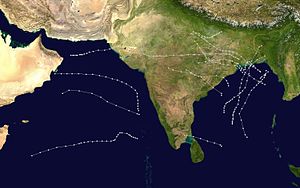1970 North Indian Ocean cyclone season
| 1970 North Indian Ocean cyclone season |

Season summary map
|
| Seasonal boundaries |
| First system formed |
May 2, 1970 |
| Last system dissipated |
November 29, 1970 |
| Strongest storm |
|
| Name |
Bhola Cyclone |
| • Maximum winds |
185 km/h (115 mph) |
| • Lowest pressure |
966 hPa (mbar) |
| Seasonal statistics |
| Depressions |
15 |
| Deep depressions |
11 |
| Cyclonic storms |
7 |
| Very severe cyclonic storms |
3 |
| Total fatalities |
300,000–500,000 (Deadliest Tropical Cyclone Season Recorded Worldwide) |
| Total damage |
$86.4 million (1970 USD) |
| Related articles |
|
|
North Indian Ocean tropical cyclone seasons
Pre-1980 North Indian Ocean cyclone seasons
|
| Very severe cyclonic storm (IMD) |
|
|
| Duration |
May 2 – May 7 |
| Peak intensity |
150 km/h (90 mph) (3-min) 975 hPa (mbar) |
| Depression (IMD) |
|
|
| Duration |
May 23 – May 24 |
| Peak intensity |
45 km/h (30 mph) (3-min) |
| Severe cyclonic storm (IMD) |
|
|
| Duration |
May 28 – June 2 |
| Peak intensity |
95 km/h (60 mph) (3-min) 986 hPa (mbar) |
| Cyclonic storm (IMD) |
|
|
| Duration |
June 7 – June 11 |
| Peak intensity |
≥65 km/h (40 mph) (3-min) 986 hPa (mbar) |
| Deep depression (IMD) |
|
|
| Duration |
June 29 – July 3 |
| Peak intensity |
≥50 km/h (30 mph) (3-min) |
| Deep depression (IMD) |
|
|
| Duration |
July 6 – July 8 |
| Peak intensity |
55 km/h (35 mph) (3-min) ≤ 992 hPa (mbar) |
| Depression (IMD) |
|
|
| Duration |
August 17 – August 19 |
| Peak intensity |
45 km/h (30 mph) (3-min) |
| Cyclonic storm (IMD) |
|
|
| Duration |
September 2 – September 13 |
| Peak intensity |
65 km/h (40 mph) (3-min) |
| Deep depression (IMD) |
|
|
| Duration |
September 8 – September 18 |
| Peak intensity |
55 km/h (35 mph) (3-min) 990 hPa (mbar) |
The 1970 North Indian Ocean cyclone season had no bounds, but tropical cyclones in the North Indian Ocean tend to form between April and December, with peaks in May and November. The 1970 season saw a total of seven cyclonic storms, of which three developed into severe cyclonic storms. The Bay of Bengal was more active than the Arabian Sea during 1970, with all of the three severe cyclonic storms in the season forming there. Unusually, none of the storms in the Arabian Sea made landfall this year. The most significant storm of the season was the Bhola cyclone, which formed in the Bay of Bengal and hit Bangladesh on November 12. The storm killed at least 300,000 and possibly even over half a million people, making it the deadliest tropical cyclone in recorded history.
A low pressure area that developed over the southern Andaman Sea late in April moved north into the Bay of Bengal becoming the first depression of the year on May 2. The depression intensified under the influence of a high-level anticyclone and became a cyclonic storm the next day. The storm then turned to the northeast and strengthened into a severe cyclonic storm on May 4. Soon after this, it peaked with winds of 150 km/h (90 mph) and a well-defined eye formed. The storm made its landfall near Cox's Bazar in easternmost East Pakistan (now Bangladesh) early in the morning of May 7 and dissipated over western Burma that evening.
The cyclone brought widespread rain to the Andaman and Nicobar Islands before it moved clear of them on May 3. Effects in East Pakistan are unknown, but Akyab in western Burma reported winds of 55 km/h (35 mph) as the cyclone approached land.
...
Wikipedia

















